Over 500 Prominent Iranian-Americans Urge Biden Not To Delist IRGC
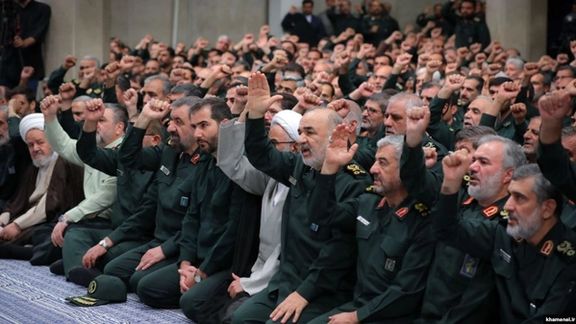
A group of more than 500 Iranian American scientists and scholars have urged President Joe Biden not to remove Iran's IRGC from list of Foreign Terrorist Organizations.

A group of more than 500 Iranian American scientists and scholars have urged President Joe Biden not to remove Iran's IRGC from list of Foreign Terrorist Organizations.
The letter, led by University of Connecticut professor and dean of the School of Engineering, Kazem Kazerounian, said the regime’s demand to delist the IRGC is “unquestionably against the will and interest of the Iranian people, and a direct threat to the advancement of democracy.“The IRGC is the tool of terrorism abroad and repression of people on the streets of Iran… This instrument of terror safeguards the religious dictatorship in Iran, and continues to impede all progress towards human rights”,Pointing out Iranians’ century-long struggle “for freedom", the signatories said that "removing IRGC from the FTO list will project blatant disregard for the hope and legitimate struggle of Iranians for freedom and dignity”.The letter added that not only “IRGC has not shown the slightest indication of good faith efforts in halting malign behavior”, it is playing “a bigger role in creating proxy naval terror units, employing UAVs for terror operations, and funding terrorism around the globe”.Since February 2021, the Iranian Professionals' Ad Hoc Committee on Iran Policy, coordinated by Kazerounian, has sent other open letters to Biden, each signed by several hundreds of Iranian Americans scholars, professors, physicians, industry executives and successful entrepreneurs.
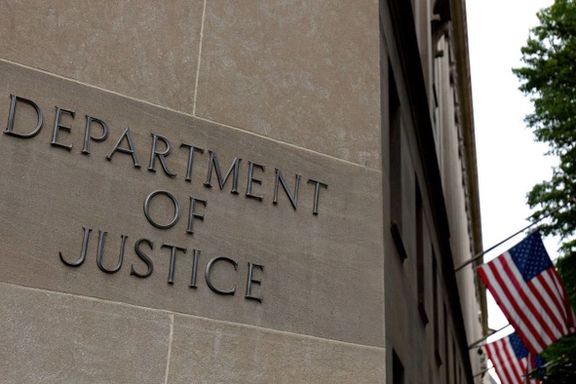
During a second detention hearing in a Washington DC court, prosecutors said they are looking to see if two suspects arrested last week have any foreign links.
Lawyers for the two men arrested last week for allegedly posing as United States Department of Homeland Security (DHS) agents have said prosecutors took their actions out of context.
Arian Taherzadeh, 40, with Iranian origin and Haider Ali, 35, originally from Pakistan, both US citizens, are charged with impersonating a federal officer. But authorities allege that the suspects lavished expensive gifts on Secrete Service and other federal personnel, ostensibly to get close to them.
On the first day of a detention hearing in Washington DC Monday, Judge G Michael Harvey said he had authority to convict the pair and sentence them to three years’ jail, Iran International’s Arash Alaei reported from the courtroom.
Defense attorneys on the second day of the hearing on Tuesday said their clients had not obstructed justice, that the federal prosecutor had jumped to conclusions, and that the men’s actions had been overblown into a media frenzy, which has included talks of links to Iranian intelligence.
Prosecutors told the second session of the hearing that four federal agents were “compromised” because of contacts with the suspects. One is a Secret Service agent in First Lady Jill Biden’s protection detail. However, prosecutors are still not accusing the men of being agents for a foreign intelligence service, although they continue to look into that.
It is not clear why the suspects spent large suns of money to give gifts to federal personnel and maintain several expensive apartments in a Washington DC building, offering their targets free occupancy in these units. Taherzadeh also got access to the building’s security system and was monitoring the residents.
Taherzadeh’s lawyer Michelle Peterson said her client was charged with bribing federal agents due to an offer of cigars. "They have jumped to the wildest conspiracy theories imaginable over the most scant of evidence," she said.
In response to Judge Harvey calling Taherzadeh “a danger to the community” because he possessed rifles, Peterson said her client was “not a flight risk or violent, and must be freed.” The lawyer argued that “lying about his identity to common people doesn't amount to a crime.”
Ali’s attorney Gregory Smith said the allegations were preposterous: "They have been making a mountain out of a molehill, and it is time for it to end.” Taherzadeh and Ali allegedly began posing as law enforcement agents in February 2020, the month after a US drone strike in Baghdad killed Iranian general Qasem Soleimani and nine others.
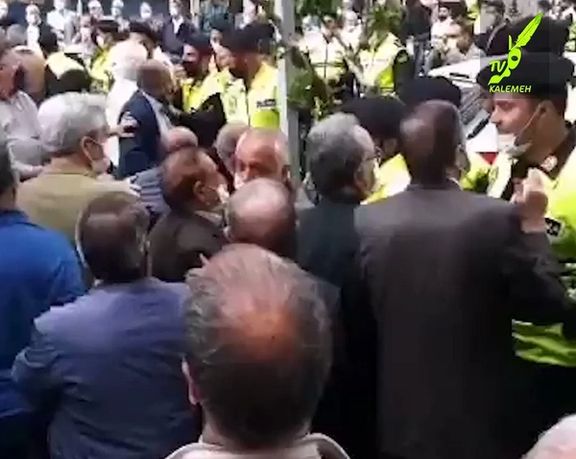
Iranian police have cracked down on a peaceful protest rally of a group of pensioners in Tehran on Tuesday and made several arrests.
According to videos and photos sent to Iran International, the protesters who were retirees of the Iranian Telecommunication Company (ITC) gathered in front of the building of Executive Headquarters of Imam Khomeini's Order -- or simply Setad, which is a quasi-state quasi-business organization under direct control of Supreme Leader Ali Khamenei, which is the main shareholder of the ITC.
They were protesting for their poor living conditions and meager incomes and chanting slogans against “injustice in the country.”
In a controversial deal in October 2009, the company was transferred to the Etemad Mobin consortium, whose main shareholders were the Revolutionary Guard and the Setad. In 2018, the IRGC announced that it had transferred its shares to Setad too.
In recent months, current employees and retirees of the company have repeatedly staged protest rallies.
With consumer price inflation hovering over 40 percent, and food prices rising faster after four years of United States ‘maximum pressure’ sanctions, Iranian workers and retirees have been holding regular protests or strikes to demand higher salaries.
Hundreds of striking and protesting workers and labor activists have been arrested since 2017, many spending months in prison. Some are still detained without trial.

An Iranian lawmaker says the government must cooperate with Saudi Arabia and Iraq to mitigate recurring dangerous dust storms sweeping Iran and the region.
"Dust storms will definitely recur in the coming months, and more frequently if we can't solve the problem through diplomacy and international relations with countries such as Saudi Arabia and Iraq where dusts originate from," Karim Hassani, member of parliament from Ahvaz in the southwestern province of Khuzestan, said.
Hassani urged the government of President Ebrahim Raisi to form a joint committee with regional countries as well as international bodies including the World Health Organization (WHO) to find ways to mitigate the problem.
Long-term measures to reduce dust storms include management of water resources and planting drought-resistant trees in deserts to hold down sands. Iran has for years used different methods to stabilize sand dunes with vegetation restoration, but not sufficiently.
Saudi Arabia and other regional countries also aim to plant billions of drought-resistant trees in the coming decades to reduce carbon emissions, pollution and land degradation.
Since mid-March, massive dust storms have hit various parts of the country, including the capital Tehran. Dust and sand originate both within Iran and in neighboring countries. Dust storms have caused a health crisis in recent days and forced the government to shut down schools and government offices in some cities and cancel outdoor sporting events. Officials warned of another wave hitting on Tuesday and Wednesday.
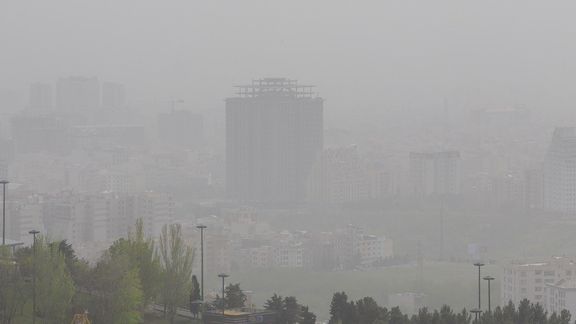
The capital Tehran was logged as the most polluted city in the world on Friday with air quality hazardous and visibility very low largely due to the very high level of airborne particles.
Dust storms and other pollutants have increased markedly in recent years in several Iranian provinces, including Khuzestan, Kermanshah, and Sistan-Baluchestan.
Although air quality in Tehran is generally bad due to the huge number of inefficient vehicles, industries, and the city's position at the foot of mountains that trap pollution, recent levels of pollution are unprecedented.
Municipality and health ministry officials have attributed the very high level of pollution in Tehran and other cities including the west and southwest of the country in recent days to dust coming from neighboring Iraq.
Sand and dust storms affect much of North Africa and countries in the Middle East. While many sandstorms have natural causes, environmentalists blame anthropogenic factors such as building dams on rivers and drying of marshes and wetlands for desertification of vast areas.
In Iran's southwestern Khuzestan Province, for instance, the building of Gotvand dam on the Karoun river to support industries such as steel in other provinces and drying ancient marshes and lagoons to dig for oil have created vast sources of anthropogenic dust storms.
But Khuzestan is not the only place in Iran where mismanagement of water resources has created potential sources of dust storms. Lake Urmia (Urumieh), once a navigable lake in northwestern Iran, has shrunk to half its size in the past four decades due to allocation of water from rivers that fed it to agriculture.
In some cases, the building of dams hundreds of miles away in other countries can create potential sources of dust that affect Iran. Building of dams in Turkey, for instance, has caused loss of vegetation in Iraq.
Building of the Kamal Khan Dam in Afghanistan has also led to the drying of Hirmand (Helmand in Afghanistan) river, which flows into Iran's Sistan and Baluchestan Province feeding the Hamoun lake and its once green surroundings.

Iran summoned Afghanistan’s chargé d'affaires over an attack Herat consulate on Monday, and suspended services of all its consular missions across the country.
The head of the South Asia Department at Iran’s Foreign Ministry, Rasoul Mousavi, said on Tuesday that the missions of the Islamic Republic will resume their services once Afghanistan ensures their security.
Protestors Monday attacked the Iranian consulate in Herat, Afghanistan, hurling stones, smashing security cameras, and burning tires before they were dispersed by Taliban security. Earlier on Monday, demonstrators outside Iran’s embassy in Kabul held banners with pictures of refugees and the words "Isn't Afghan a human being?"
Interior Minister Ahmad Vahidi also said on Tuesday that the attacks have been organized by “the enemy” and aimed at sowing discord between Iran and Afghanistan.
Warning of efforts on social media to whip up anti-Iranian sentiment over alleged mistreatment of Afghan immigrants in Iran, foreign ministry spokesman Saeed Khatibzadeh called on Taliban officials to ensure the security of Iran’s embassy in Kabul and its missions across Afghanistan.
Sectarian tensions have risen since last week’s killing of two Shia clerics in Imam Reza shrine, Mashhad, attributed to an Afghan migrant. Many Afghans are in Iran unofficially, with numbers increasing since the Taliban took Kabul last year as the United States ended its 20-year military presence.
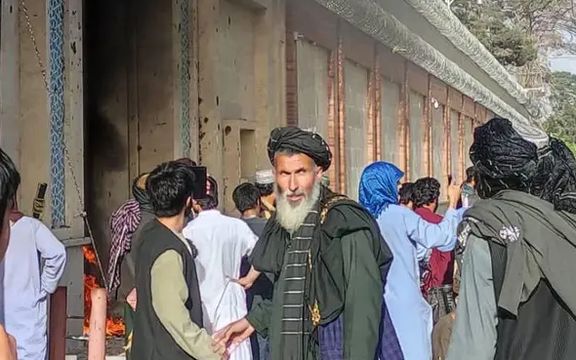
Tehran on Tuesday summoned the Afghan chargé d'affaires to protest an attack on its consulate in Herat on Monday and halted consular services in Afghanistan.
According to a statement published on the its website, the ministry's director-general for South Asia told the Afghan chargé d'affaires that Tehran will not resume its consular services before receiving assurances from Afghan authorities over protection of its diplomatic missions in Afghanistan. The Iranian official also demanded punishment of those behind the attack.
Protesters on Monday set fire to tires in front of the Iranian consulate in Herat, pelted the building, burned the Iranian flag, and destroyed security cameras. Taliban forces reportedly dispersed the angry Afghan crowd by firing shots in the air.
According to Afghanistan's TOLOnews, dozens of Afghans protested against Iran in Kabul and the south-eastern province of Khost. A banner carried by protesters in Kabul Monday said "Stop Killing Afghans" while another said Afghans will never forget the mistreatment of their compatriots in Iran. A video published on Twitter by Afghanistan's Aamaj News shows protesters marching in front of the Herat consulate and chanting "Death to Iran".
Tensions between Iranians and Afghans have risen since last week’s killing of two Shiite clerics at Imam Reza shrine, Mashhad, reportedly by an Afghan national.
Following the attack some videos began circulating on social media to portray mistreatment of Afghans by Iranians. The videos alleged that some Afghans had been verbally, physically, and sexually abused by Iranian mobs, border guards and police. The authenticity and time of the videos cannot be independently verified.
In an interview with Afghanistan's TOLOnews on Monday, the Iranian envoy to Kabul, Bahador Aminian, claimed that the Mujahedin-e Khalq, a group based outside Iran and considered as a terrorist group by Tehran, was behind the dissemination of the provocative videos on social media to ruin Tehran-Kabul relations.
Tasnim news agency which is affiliated to Iran's Revolutionary Guards (IRGC) on Monday claimed that "western-backed" political groups in Afghanistan were behind the recent events and have called for more protests against Iran in the coming days.
At his weekly press briefing on Monday, after the attack on the consulate in Herat, Iran's foreign ministry spokesman, Saeed Khatibzadeh, said the influx of Afghan refugees to Iran cannot continue considering Iran's limited capacities and urged the Taliban to exercise responsibility and to protect Iranian diplomatic venues in Herat and other Afghan cities.
Khatibzadeh also said there were plots by "certain ill-wishers" to foment Iranophobia in Afghanistan and Afghan-phobia in Iran.
The Taliban foreign ministry on Friday said it had summoned officials of the Iranian embassy in Kabul in connection with "abuses against Afghan refugees in Iran" following the recent stabbing of Iranian clerics in Mashhad.
Last week Foreign Minister Hossein Amir-Abdollahian said since the Taliban took power in August last year one million more Afghans have entered Iran, bringing the number of refugees and economic migrant to five million.
Thousands of Afghans fleeing the economic hardships under the Taliban enter Iran daily from official border points or illegally from other areas along the 900 km border to find work in Iran to support their families back home or to continue their journey towards Europe.
Some officials claim as many as 5,000 Afghans a day have been entering the country in recent months.